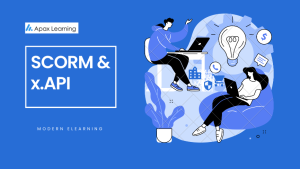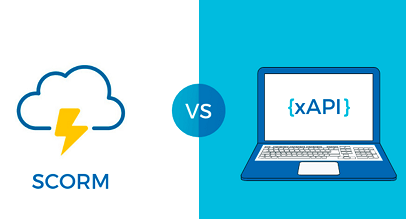Displaying Your Skills: An online portfolio is a powerful tool for instructional designers, allowing them to showcase their expertise. It attracts potential employers or clients when combined with a strong online presence. Moreover, it aids in self-assessment and skill improvement
The Evolution of eLearning Standards: SCORM & xAPI

Before we embark on the journey of comparing xAPI and SCORM, it’s crucial to first gain a deeper understanding of the historical context in which these eLearning standards emerged and evolved. Understanding their origins, the challenges they were designed to tackle, and the benefits they aimed to deliver will provide a more comprehensive perspective on their strengths and weaknesses in the realm of modern online education.
SCORM
The Emergence of SCORM
SCORM (Sharable Content Object Reference Model) has long been the go-to standard for eLearning content packaging and delivery. It was developed in the late 1990s by the Advanced Distributed Learning (ADL) initiative, a part of the U.S. Department of Defense. This was designed to ensure interoperability and reusability of eLearning content across various learning management systems (LMSs).
The core principles include:
- Content Packaging: It enables the bundling of eLearning content into self-contained modules known as SCOs (Sharable Content Objects). These can be easily imported into different LMSs, making content sharing and distribution more straightforward.
- Sequencing and Navigation: It defines how content should be sequenced and navigated, allowing for standardized tracking of learners’ progress within a course.
- Communication: It specifies a set of runtime communication protocols that enable LMSs to track learner interactions and report them back to a central repository.
Benefits of SCORM
- As previously mentioned, it is widely recognized as the industry standard in eLearning, and it holds this position for several compelling reasons. Here are some of the primary advantages of SCORM content:
- Industry Support:It enjoys extensive support within the eLearning industry, resulting in a wealth of information, support, and resources available for its implementation.
- Consistency: It provides a standardized framework for delivering eLearning programs, ensuring that the quality of training remains consistently high.
- Compatibility: It seamlessly integrates with various learning platforms and devices, offering a straightforward and accessible training experience.
- Reusability: Content that complies with it can be easily shared and reused across different systems, reducing the expenses associated with content development.
- Robust Reporting: It offers robust reporting capabilities, enabling the tracking of essential metrics like course completion status, learner progress, and test scores.
- Scalability: Being an industry standard, it supports the expansion of online training initiatives without compromising functionality or the learner experience.
xAPI
The Rise of xAPI
While SCORM served the eLearning community well for many years, it had limitations. It primarily focused on tracking formal learning activities within the LMS, leaving informal and experiential learning experiences uncharted. This gap led to the development of xAPI (Experience API), also known as Tin Can API.
It released in 2013, aimed to address the shortcomings of SCORM by offering a more versatile and comprehensive approach to learning experience tracking. It was developed by the Advanced Distributed Learning (ADL) initiative as well, signaling a shift toward more modern eLearning standards.
The key features include:
- Broad Learning Experience Tracking: ,It is not limited to tracking activities within an LMS. It can capture a wide range of learning experiences, both online and offline, formal and informal, such as reading a book, attending a conference, or completing an eLearning module.
- Data Portability: It allows data to be stored in a Learning Record Store (LRS), which can exist independently of an LMS. This flexibility makes it easier to track and analyze learning experiences across different platforms and systems.
- Adaptive Learning: It supports adaptive learning by enabling the collection of detailed data about learners’ interactions. This data can be used to personalize learning experiences based on individual preferences and performance
Benefits of xAPI
While Experience API is a relatively new eLearning standard, it offers several compelling advantages that make it a valuable addition to your learning process. Here are some of the most noteworthy benefits:
- Advanced Tracking Capabilities: It goes beyond traditional eLearning courses by tracking learning experiences in various formats, including training simulations, mobile apps, and games. This comprehensive tracking provides a more holistic view of learner engagement.
- Enhanced Interoperability: It can capture data from diverse learning systems, facilitating seamless integration and the consolidation of data from multiple sources. This interoperability ensures that you can gather data from various platforms and tools.
- Detailed Insights: It offers in-depth insights into learner behaviors, preferences, and performance outcomes. This wealth of information enables educators and organizations to make data-driven decisions and tailor learning experiences more effectively.
- Scalability: It is highly flexible and can adapt to accommodate new technologies and evolving standardizations. This scalability ensures that it remains relevant as your learning environment evolves.
- Multiple Data Formats: It supports a wide range of data formats, including text, timestamps, and attachments. This versatility allows for detailed capturing of learner data, making it easier to analyze and utilize for instructional improvements.
- Personalized Learning: It instructional designers can create highly personalized learning experiences based on individual learner needs, behaviors, and preferences. This personalization enhances engagement and learning outcomes.
All of these benefits empower eLearning content developers to make more informed, data-driven learning decisions.
SCORM vs. xAPI: A Detailed Comparison
| SCORM | x.API | |
| Data Tracking and Learning Experiences | – Designed primarily to track and manage data related to formal learning experiences within an LMS
– Outstanding in monitoring completion status, quiz scores, and other standardized metrics for SCOs. | Highly flexible in tracking multiple learning experiences.
– Capable of collecting data from various sources, including mobile apps, simulations, social learning platforms, and even real-world activities like on-site training. – A powerful tool for measuring and analyzing all learning experiences, both formal and informal, within and outside the LMS |
| Interactivity | High interactivity capability. Content that adheres to these e-learning standards can be easily integrated into different LMS without significant compatibility issues. This ensures that eLearning content can be seamlessly shared and reused across various systems | The interaction capability is good but needs a different approach. It emphasizes the mobility of data rather than content. xAPI data can be stored in an LRS, allowing organizations to use multiple LMS while still tracking and analyzing data consistently. |
| Reporting and Analytics | – Provides basic reporting capabilities, allowing organizations to track progress, completion rates, and learner assessment scores
– Lacks the ability to provide advanced analytics and detailed insights into learner behavior and interactions. | – Excels in reporting and analysis
– Can collect detailed data on learner interactions, allowing organizations to gain deeper insights into how learners engage with content. Then, it used to create personalized learning pathways, identify areas for improvement, and assess the effectiveness of various learning experiences. |
| Adaptability | – Well-suited for traditional eLearning courses with linear content and assessments. – It struggles to accommodate modern learning approaches, such as adaptive learning and microlearning, which require more flexibility in tracking and content delivery. | – High adaptability.
– Collects detailed data on learner interactions to personalize the learning experience, adjust content quickly, and create dynamic learning pathways. |
| Offline Learning | Mainly applied in online learning environments | – Excels in tracking both online and offline learning experiences.
– Can collect data even when learners are not connected to the Internet |
| Future-Proofing | Capabilities are considered somewhat outdated | – It’s a future-proof standard due to its adaptability
– It’s well-positioned to evolve within the ever-changing landscape of eLearning and digital education. |
Conclusion
The choice of 2 Modern eLearning and xAPI depends on your specific eLearning needs. SCORM is a reliable option for traditional online learning within an LMS, while xAPI offers flexibility, robust reporting, and adaptability for tracking diverse learning experiences. We hope you can choose the learning methods that best suit your goals and preferences.
